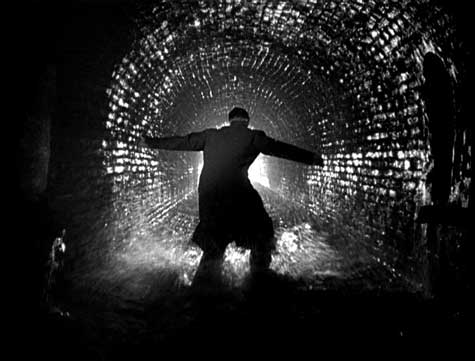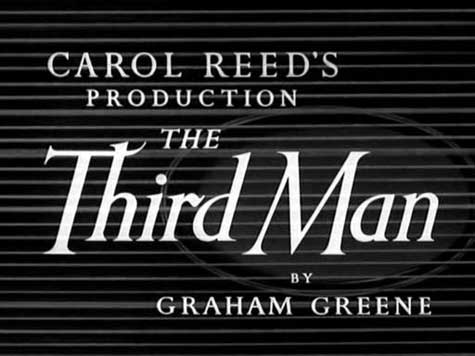
Joseph Cotten holds a peculiar place in movie history. He was a charismatic and bankable movie star in the forties, and he was a fine actor and an all-around nice guy, but he lived most of his adult life, and will likely live throughout the ages, in the shadow of his friend Orson Welles. Even though Cotten was the bigger star, Welles was somehow the bigger presence. This was never more obvious than in Carol Reed’s The Third Man, a masterpiece of film noir and perhaps the biggest success of either actor’s career.
Based on the novel by Graham Green (who also wrote the screenplay) The Third Man tells the story of an American pulp novelist named Holly Martins (Cotten) who travels to Vienna after WWII to meet up with an old friend named Harry Lime (Welles). Upon arriving, however, Martins discovers that Lime has been killed in a hit and run accident. At the funeral, he meets a beautiful young woman named Anna (played by Alida Valli), the one person who seems truly upset by Lime’s death. He also meets Major Calloway (Trevor Howard) the army official in charge of policing the English section of Vienna. Calloway is not upset by Lime’s death. In fact, he has some gruesome news for Martins: Harry Lime was a criminal—no, worse, Harry Lime was a downright villain.
SEE ALSO: Is Graham Greene the greatest thriller writer ever?
The exact details of Lime’s crimes, and the events that unfold as Martins begins to look into the curious events surrounding his friend’s death are one of the pleasures of the film, so I’ll avoid getting too specific about plot points. In way, though, the chief pleasure of the film isn’t the story at all but the milieu and the magnificent direction of Carol Reed. The Third Man is, simply put, one of the most beautiful films ever made. Reed shoots at slanted angles, rarely going for a conventional shot when he can visually approximate the unsettled nature of Cotten’s descent into the European criminal underworld. His main collaborator is cinematographer Robert Krasker, whose work here is not just beautiful, it is a flawless use of the medium of black and white film. There may be no better argument for the superior artistry of black and white than this movie.

Of course, more than a few viewers have noted that the film looks a lot like an Orson Welles film. Reed was a fine director, but The Third Man sure looks like its director studied Citizen Kane before he shot it. Since people already know that Welles appears as Harry Lime, it makes sense that the question of his influence would arise. As far as his impact on the style of the film, however, all we have to go on is the word of Welles himself who was unequivocal that he had nothing to do with the direction of the film. As he told Peter Bogdanovich years later, “Carol Reed didn’t need me to tell him where to put a camera.” It should also be noted that the sequences from Welles’s work that most resemble The Third Man can be found in Mr. Arkadin and The Trial, films that appeared after this one.
What is certain is the way Welles’s presence affects the whole film. The story, which has been excellent before Welles’s arrival, suddenly kicks into overdrive once he appears. Welles himself attributed this power to the structure of the plot—after all everyone in the film is focused on his character—but it also owes a lot to the sheer magnetism of Welles as an actor. Perhaps because he was such a fine director, or because he worked as an actor-for-hire in so many inferior productions, it is sometimes overlooked what a great screen performer Welles could be. He breezes into this movie over halfway through and blows everyone else in the cast off the screen. Cotten, who was ten years older than Welles and was by far the more bankable movie star, simply fades in comparison. What’s so fascinating about The Third Man is how it uses this subtext as a driving force in the main storyline. Martins is in love with Anna, but Anna is in love with Harry. For all his faults, Harry is simply the more compelling man. Welles is in the film for barely ten minutes, but he dominates it. He wrote its most famous dialogue (the little speech about the Cuckoo clock), and he stars in the most famous sequence (the race through the sewers). For all intents and purposes, Orson Welles is central force of The Third Man.
Yet, Joseph Cotten is, in more ways than one, the main character, the innocent American discovering the harsh realities of the postwar world. While Harry Lime has made his peace with evil and decided to cash in, Martins is struggling to find his equilibrium in the postwar world, much as America was trying to do in the aftermath of so much death and destruction. Welles the genius, the larger than life figure, is perfect as the flamboyant crime lord. Cotten, decent and beleaguered, is perfect as a stand-in for the rest of us.
Jake Hinkson is the author of several books, including the novel The Big Ugly, the newly-released short story collection The Deepening Shade, and the essay collection The Blind Alley: Exploring Film Noir's Forgotten Corners.
Read all of Jake Hinkson's posts for Criminal Element.

Postscript: The Third Man was an important movie for Welles. Not only did it give him a much needed box office success and a nice paycheck (which he funneled into his independent production of Othello), it also set him up for years to come. He did a lucrative radio show in the fifties, The Lives of Harry Lime,in which Lime is reconfigured as a kind of globetrotting international man of mystery. Welles later cannibalized the plot of one of the show’s episodes as the set up to his film Mr. Arkadin.
THE THIRD MAN continues to be my favorite film of all time. Some come and go and others shift around in the #2-10 slots, but this little bit of perfection refuses to ever be knocked out of the top spot. A nearly perfect film. And just when you think that the movie has nothing left to give, you get Anna’s long walk at the end.
Always been an Orson Welles fan and The Third Man is one of my favorites. As many times as I’ve seen it, I was very surprised that Wells was only on screen for about 10 minutes. He dominates the film, even when not on screen. That is an extremely rare quality even today!